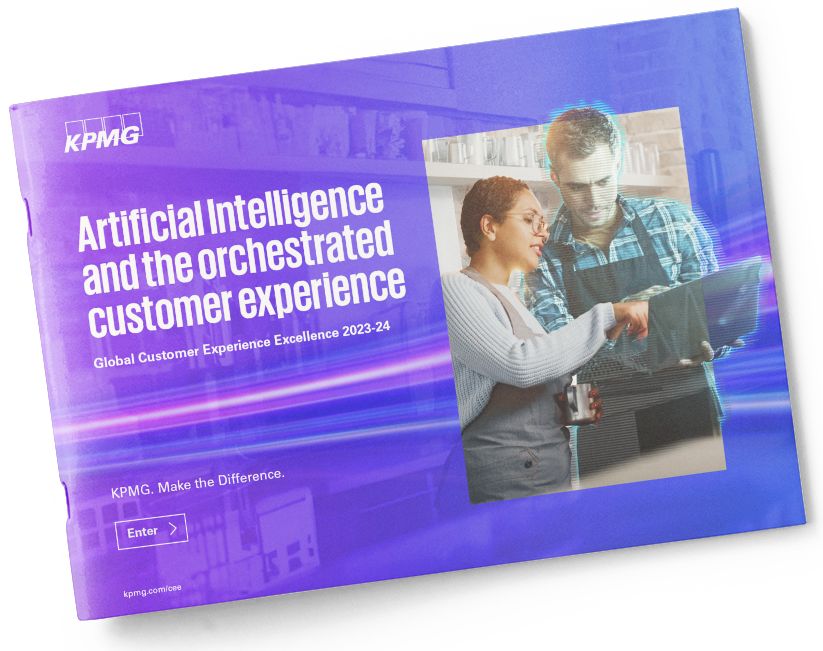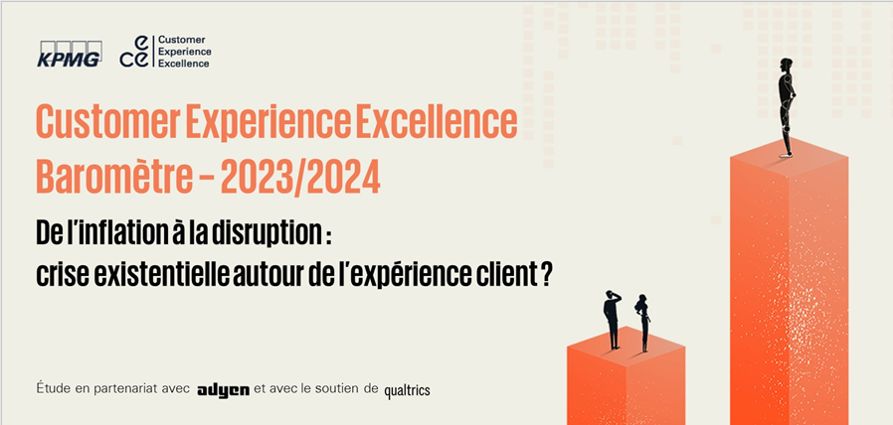Artificial Intelligence and the orchestrated customer experience
Global Customer Experience Excellence 2023-24
21
Countries & territories
81,725
Customers Interviewed
821,824
Customer evaluations
2,726
Brands
Scaling personalized customer experiences with AI
Artificial Intelligence (AI) is opening up new and profound possibilities for organizations to deeply personalize the customer experience like never before.
With AI, companies can transform the customer journey and radically rewrite the rules of the game. They can also improve costs to serve, reduce friction and improve customer satisfaction.
For 14 years, KPMG professionals have been asking consumers about their individual experiences with brands. This year, the KPMG Global Customer Experience Excellence (CEE) 2023-24 report explores what AI will mean to the customer experience. It investigates how companies can use AI to orchestrate journeys across the enterprise to deliver stand-out experiences that will win customers time and time again.
Yet, today's technology is holding brands back. The 2023-24 CEE report saw a global decline in customer perceptions of their experiences. Only two countries out of the 21 included in this year's study, saw a rise in customer satisfaction. The remainder all witnessed declines, and in some countries, a significant decline. Customer attribute the decline to an overall failure of brands to meet their expectations. Technology was also identified as a contributor.
The KPMG Global CEE 2023-24 report examines emerging best practices in AI implementation.
It explores how the top organizations leading in customer experience are striking the right balance between humans and machines, and what we might learn from them.
The forces behind rising customer expectations
Customer expectations are rising. Cost-of-living concerns and customer deflection to low-cost and low-satisfaction channels are diminishing customer perceptions of their experiences. Understanding the forces behind today's customer experiences can help companies focus on the strategies that will unlock customer loyalty and deliver growth today and tomorrow.
Customer experience quality is falling
The availability of advancing technologies offers companies low-cost channels to support customers. Too often these are a poor substitute for human interaction, leaving customers feeling underwhelmed and frustrated.
4% decline in organizations meeting customer expectations in 2023
97% of consumers say they have been impacted by inflation and cost-of-living increases at some level
Over one quarter of customers extremely impacted by cost-of-living crisis
8 of this year's top organizations also ranked number 1 last year and sit at the forefront of technology.
61% of consumers are willing to pay more for brands that align to their ethical values.
Technology is only one part of the answer
Customers today want an emotional connection – they want to feel their brands reflect their personality, their lifestyle and their values. Technology needs to reflect this. When it does not, the customer experience diminishes.
Economic impact on value and values
Macroeconomics continues to play a part in shaping customer opinions of their experience with companies. For most countries, the cost-of-living crisis weighs heavily on customers' decision making and impacts how they perceive value.
The Six Pillars of Customer Experience Excellence:
Even in a world fueled by technology and affected by a cost-of-living crisis, the KPMG Six Pillars of Customer Experience remain the essential dimensions of great customer experiences. They act as design principles, providing guidance on where companies should focus to improve experiences for customers.
Personalization
Using individual attention to drive an emotional connection
Empathy
Achieving an understanding of the customer's circumstances to drive deep rapport
Expectations
Managing, meeting and exceeding customer expectations
Time and Effort
Minimising customer effort and creating frictionless processes
Resolution
Turning a poor experience into a great one
Integrity
Being trustworthy and engendering trust
Customer experience around the globe
Click on a country or territory below for more information. To access our previous years' reports, please click here.
Australia
The Australian customer experience
Consumers in Australia are becoming savvier and demanding more from their brands: more personalized experiences, more value for their dollar and more seamless omnichannel experiences. These higher demands have led many brands to see a drop in their Customer Experience Excellence metrics scores this year versus 2021, when the survey was last conducted in this market.
Leading the brand rankings this year is Bunnings Warehouse, who climbed from fourth place in 2021. Over the last two years, the home and lifestyle retailer has invested in expanding its digital data capabilities to improve personalization for their DIY and commercial customers. They also introduced a new e-commerce platform and in-store technology to reduce the time that staff spend performing tasks, which is better spent servicing customers and improving the shopping experience. These investments led Bunnings to be the market leader for three of the six pillars, including Integrity, Time and Effort, and Resolution.
The Body Shop has risen back into the Top 10 this year, taking second place and leading the Empathy pillar. A key strategy behind their move up the rankings appears to be the brand's decision to incorporate sustainability into their value chain. In doing so, they embraced the growing number of sustainably conscious consumers and offered them experiential initiatives in-store.
Long renowned for their in-store customer experience, Mecca who came in third place this year, has shifted its focus to blending content, commerce and customer experience online, while also maintaining their strong in-person retailing presence. Mecca's focus on personalization and experience are at the core of their technology and digital investments. They now have a single view of the customer, which they can recognize at any point in their journey to better cater to individual needs and preferences. The brand's willingness to adapt to consumers' new way of shopping with their ecommerce investments has contributed to their becoming a market leader in meeting customer expectations.
The grocery retail sector performed well on the Time and Effort pillar, landing them in the top industry spot for customer experience. As hybrid and work from home arrangements persist, consumers prefer “single basket visits” over weekly or bi-weekly hauls. To capture this segment, the major retailers have continued to invest in small market stores conveniently located near public transport. The non-grocery retail sector, on the other hand, has been challenged in the second half of 2023, as inflationary pressures have reduced discretionary spending for many consumers.
“Personalization continues to be recognized as the number one driver for customer experience in Australia. Customers are looking for brands to not just know them, but understand them. AI is increasingly becoming an ally in a brand's technical transformation; although, we continue to see the importance of a customer centric, and often human, approach to digital transformation. These changes allow brands to establish a new foundation for differentiation via personalization and omnichannel experience orchestration.”
Karen Halligan
Partner, Customer & Operations Advisory
KPMG Australia
Top 10 Companies*
*listed in alphabetical order
- Apple
- Bendigo Bank
- Bunnings Warehouse
- Chemist Warehouse
- Dan Murphy's
- JB Hi Fi
- Mecca
- Specsavers
- The Body Shop
- THE ICONIC
Customer experience from the sector lens
Banking
The banking sector has navigated a sea of changes in recent years – geopolitical shifts, economic uncertainty, advances in technology, energy and climate concerns, the fight for talent and rising customer demands. On top of this, the industry has undergone sweeping transitions.
Fueled by strong capital and liquidity positions, the industry has shown cautious optimism. Ranked as the second leading sector globally, first direct in the UK, Air Bank in Czech Republic, Kbank in Thailand and Maybank in Malaysia were each named the top brand in their respective countries.
These and others in the industry are carefully managing risks in the face of such uncertainty, and are prepared to forge forward on the strategies they consider important. This includes progressing against their ESG targets and making the most of emerging technologies.
The banking sector has long used AI to understand its customers and competitively price its products. Yet, the rise of today's AI, especially common-language generative AI (gen AI), is getting banks to test what is possible with new use cases across operations.
Already, AI has been helping banks respond to post-pandemic surges in digital interactions and transactions. The technology is also helping create more nuanced individual customer profiles, so banks can create and introduce tailored products and services at the right time.
Winning clients for life
Customers' time and effort is a key focus for banks. They want to give customers frictionless, multi-channel experiences where customers can seamlessly interact across various platforms – be they through machines or with humans, and delivered in person or virtually. They also want to transition how they serve customers. Instead of focusing on short-term product sales, the goal is to win the 'client for life' – a concept that is gaining ground across the industry.
In this model, banks deliver a personalized portfolio of products and services that support customers through specific life events. To further enhance this approach, banks are moving toward an alliance ecosystem. Here, banking products and services will integrate with offerings from various complementary sectors – auto insurance contacts for those seeking car financing or home builder contacts for mortgage customers – to create a comprehensive customer experience.
AI will likely be instrumental in this shift. Going beyond understanding customer behavior, AI can enhance and personalize the entire customer journey. It can interpret legacy systems, extracting valuable insights and historical data that can help enrich the customer experience, and develop, deliver and better price product offerings. The data can also help create new and efficient customer service models, and facilitate better customer orchestration within the banking organization, as well as with peripheral partners.
AI brings with it immense opportunities. It also comes with risks. From governance issues to potential bias in algorithms to data privacy, banks know they should balance these risks as they use AI if they want to build long-term, trust-based relationships with customers.
“Despite the uncertainty blanketing the banking sector, banks are cautiously optimistic on the future and are ready to leverage AI in new use cases to create a more personalized, enriched and long-term customer experience that supports customers through life events, and will keep them coming back time and time again.”
Francisco Uria Fernandez
Global Head Banking & Capital Markets
KPMG International
Insurance
The insurance sector is at a crossroads. It can remain on its current path where it will likely continue to face declining consumer trust. Or, it can choose to venture along a new path, embracing technology and customer–centricity to evolve and maintain relevancy in a rapidly changing world.
Much of the insurance industry, particularly general insurance, has become a commodity of sorts. Acting as such, insurers predominately compete on price, often at the expense of innovation and customer experience. The pandemic showed the weakness of this strategy.
The use of complex terms and inconsistent claim payouts during the pandemic, led consumers to lose trust in insurers. Trust forms the basis of the Integrity pillar, which saw a 2 percent global decline in this year's CEE report. According to KPMG research, trust is a key factor in consumers recommending a company to others.
MAIF has succeeded in retaining customer loyalty in 2023, ranking 4th overall for loyalty in France. The insurer – a standout in the industry – has been on a five–year journey to improve its customer experience, prioritizing their policyholders' well-being and satisfaction.
Few others have done the same. In the pursuit to meet customers' needs for lower prices, many insurers cut costs to customer service. Customer satisfaction has taken a hit, especially during the claim process. The claim, which is essentially the tangible product insurers sell to its policyholders, is a critical touchpoint for customer trust and loyalty – all of which are made worse when the process does not consider the customer or their experience.
The role of AI for insurers
As insurers look ahead, trust should be a primary focus, alongside optimizing operations. As new regulations emerge, insurers can benefit from aligning their policies. In the UK, for example, more progressive firms are proactively aligning to the Consumer Day requirements, which is helping to rebuild customer trust and drive growth.
Advanced technology can help support trust building. Data analytics has been long-used within the industry. Yet, insurers have done little to use their great amounts of customer data to create personalized products and experiences. The cloud can also help reduce operational costs and improve efficiency – which may soon become a necessity if insurers want to remain competitive and responsive as customers demand more agility and innovation.
Artificial intelligence (AI), too, holds significant promise for insurers. Use cases can help cut costs from an operations standpoint. More significantly, insurers can come to see AI as a new colleague – a powerful one – that can enhance team capabilities around in terms of risk management, underwriting and pricing. With such an assistant on hand, insurers can enrich the customer experience at the signup stage, and more importantly from a customer perspective, at the claim stage.
AI can also help insurers integrate their ESG values into their products – a regulatory requirement as well as a growing demand from increasingly socially conscious consumers.
The future demands adaptability, customer-centricity and advanced technologies. By embracing these, insurers can meet the evolving needs of their customer and pave the way for a more resilient, relevant and innovative industry.
“There is a generation of innovation awaiting the insurance industry. For example, AI can help address specific challenges found in the claims process or underwriting. It can also be used to analyzed the already rich pool of data to create products which are more relevant to the emerging needs of customers and businesses. Furthermore, with challenges the industry faces in selecting increasingly high risks against a backdrop of climate change and instability, AI could be leveraged to reverse decline in risk appetites. With AI, the possibilities seem endless. To capture the opportunities ahead of them, insurers will need to see their role beyond a commodity, and rethink the link between customer experience and commercial value.”
James Henderson
Customer Insurance Director
KPMG in the UK
Hotels
The hotel sector is riding the wave of recovery. Driven by changing customer behaviors and technological advances, the sector has emerged from the pandemic as a beacon of resilience and adaptability.
Like other sectors, the hotel recovery was challenged with labour shortages. Plus, faced with shifting traveler preferences, the industry has been industrious and creative in evolving to meet new demands and expectations.
As a result, the overall travel and hotel industry saw a 3 percent decline in their global Customer Experience Excellence (CEE) score. Yet, 5 hotels stood out to customers, who ranked them among the top 10 in 3 markets. In Mexico, Marriott was ranked second and Hilton sits in sixth place. Hilton Hotels & Resorts was ranked in sixth place in the UK. In France, Mercure placed fourth, followed directly by Novotel in fifth after jumping 14 places over last year.
Adding to this upswing is consumers' growing preference for memories over merchandise. Even with a cost-of-living crisis and uncertain economic times, consumers are prioritizing their spend on leisure activities. This includes domestic and international travel as well as other unique events.
Rethinking hotel strategies for the future
Out of this, a new trend has emerged: hoteliers are using their space to host fun, entertaining experiences for guests, such as escape rooms or themed evenings. This collective focus on leisure is a marked departure from the sector's reliance on business travel, which has been slower to bounce back in the era of Team meetings and remote work.
The hotel boom has brought about operational challenges. The hotel shutdown during the pandemic saw an exodus of hotel workers, many of whom chose not to return when travel opened back up. This demanded hotels to rethink their staffing strategies, often leading to wage increases and innovative approaches to attract and retain talent.
Travel marketplaces, such as booking.com, are also challenging the sector. Starting to use generative AI, these platforms help travelers plan their vacations, and in the process, are capturing deeper, broader customer insights that go well beyond what hoteliers can capture.
In response to these challenges, hotels are embracing technology and redefining customer engagement. Hotels, like airlines, have used AI to dynamically price rooms. They are also expanding their loyalty programs across the full spectrum of their hotel brands to collect essential data to better understand their customers and help personalize experiences.
Looking ahead, such personalized experiences will need to balance between technology-led services with those delivered by humans, tuning into the specific needs of travelers in specific situations. This attention to the customer, while harnessing the power of data and AI will enable hotels to enhance operational efficiency and customer satisfaction.
“Hotels will have to find the right formula that will integrate technology at the right points to enhance the customer experience. As they do, they'll need to consider the right balance between people-led and technology-led services to match customer needs as they change over the duration of their stay. This will be especially important as hybrid leisure and business stays increase in the post-pandemic world.”
Will Hawkley
Global Head of Leisure and Hospitality
KPMG in the UK
Airlines
The airlines industry is soaring into a new era. Coming out of the hardships of the pandemic, the sector has made a robust recovery and is on track to surpass pre-COVID levels in 2024. Now, the industry is focused on reinventing itself to meet the evolving demands of customer expectations.
Emirates is one of the airlines leading the sector in exceeding customer expectations. Ranked the top brand in the UAE for the third year in a row, the airline carrier has also made significant gains in the UK, moving up the brand list to the number 11 spot, up from 92 last year.
Personalization, along with improved Time and Effort, are two key factors driving airline customers today. In the immediate aftermath of the pandemic, travelers were understanding, even forgiving, of flight delays, baggage mishaps and more. This is no longer the case. Travelers want seamless, contactless services akin to their experience in the e-commerce sector. In response, airlines are investing in technologies to enable digital interactions from check-in to in-flight services.
Sustainable and loyal: A new focus
Customer also want more efficient, environmentally conscious airlines. In response, many air carriers have made fairly bold aspirational targets in terms fuel efficient aircrafts, sustainable aviation fuels, and achieving net-zero carbon emissions from their operations by 2050. Yet, this is proving difficult to execute, especially with the high cost and low availability of Sustainable Aviation Fuels (SAF).
In addition, supply chain disruptions are making it difficult to source and purchase new, efficient aircrafts. This is made worse as the world's few major manufacturers are still behind their pre-COVID production levels. While electrification is not a significant driver in the 2050 timeline to decarbonize aircraft flight operations, the initial focus will be on electrifying ground operations, including on ground aircrafts, baggage handling, shuttles and other support vehicles.
Loyalty programs are another key strategy for airlines as they look ahead. With the availability of AI and advanced data analytics, airlines can make better use of their loyalty programs to capture detailed customer data and analyze it in ways that will allow them to more deeply understand their customers’ travel habits and preferences. All so they can better anticipate their needs and wants, and tailor services on the ground and in the air.
Part of enhancing their loyalty program will be building on their already successful ecosystem of partners. Where today they are partnering with banks and local travel providers, in the future they may consider other partners who touch the customer in their overall travel journey.
From taxis to airports, each part of the travel journey affects the customer experience. Gaining more control over this extended experience and creating a more cohesive experience will likely become the future for airlines. The challenge, of course, will be navigating the complexities of data sharing and partnership dynamics while making the most use of AI.
“The airline industry is inherently physical – it requires moving people from point A to point B – so a fully digital experience isn't possible. The trick for airlines then is to integrate digital experiences at the right points and at the right times for its customers, without fully disconnecting the human touch. Offer a contactless check-in, while ensuring staff is available to provide support if and when needed to make the experience smooth for the customer.”
Malcom Ramsay
Global Head of Aviation
KPMG in Singapore
Retail
Coming soon
Telecoms
The future of telco is upon us. As technologies are advancing, market dynamics are shifting, competition is heating up and customer expectations are intensifying, telco companies are having to rethink and reimagine their business and operating models.
Overall, the telco industry saw a 3 percent decline in their CEE scores in 2023 versus the previous year. With the exception of Value, the sector saw a drop across The Six Pillars. Further, of the 129 telco brands included in the study, only 4 were ranked among any of the 21 countries' top 10.
The faltering comes partly off the back of the massive investments in 5G infrastructure telcos have made in recent years to meet the surge in customers' broadband demands. With such high costs to recover, margins are being squeezed like never before, despite high consumer revenues.
With little wiggle room, consumers and commercial clients are demanding their telco companies do better. They want more flexible service, greater billing transparency and enhanced ease of use. A recent KPMG survey of US consumers revealed that 41% of respondents desire lower costs for the same service, further pressuring telcos to balance pricing with value delivery.1
Making matters worse, traditional business models rooted in providing connectivity services like voice and data are being challenged by hyperscalers – companies like Microsoft, Google or Amazon that offer similar connectivity services – which could crowd out telcos if they decide to build their own private networks. With larger budgets and more ambitious agendas, these new entrants are creating a competitive urgency across the industry.
From telco to techco
There is good news: telco companies own extensive infrastructure and a wealth of customer data. For example, telco players can bundle their network access with data-driven solutions that encompass content and data connectivity. The first step toward such a pursuit would require telcos to evolve their organizations to become more like technology companies, forging strategic alliances with hyperscalers as they try to move away from their traditional branding as network infrastructure providers. They are leaning into that claim by launching new products and services that help them move up the technology stack.
Advanced technologies can help alleviate the demands for massive infrastructure investments. More broadly, AI can help evolve the industry. While the role of AI is still unfolding, it can be first used to enhance network operations and 5G capabilities, while providing smarter, more connected ecosystems. For fixed and pay-TV markets, personalization and content optimization can also benefit from AI.
Telcos will need to navigate AI carefully, considering data protection, privacy and cybersecurity. This way they can harness AI's potential without compromising customer trust or security. They will also want to elevate the customer experience, adeptly meeting client needs in the moment with innovative products and tailored service delivery.
“The rollout of 5G and, eventually, 6G will open up a range of new applications and Web 3.0 technologies. To make the most of it, telcos will need to figure out how they can leverage their massive pools of data to enhance the customer experience and build out solutions, content and connected data that can transform them into the techcos they want to become.”
Mark Gibson
Global Head of Technology, Media & Telecoms
KPMG International
Latest insights
Transforming for a future of value
Connected. Powered. Trusted. Elevate. KPMG firms' suite of business transformation technology solutions can help you engineer a different future – of new opportunities that are designed to create and protect value.
Transformation solutions


 2023 Report
2023 Report 2023 Report
2023 Report 2023 Report
2023 Report 2023 Report
2023 Report 2023 Report
2023 Report 2023 Report
2023 Report 2023 Report
2023 Report 2023 Report
2023 Report 2023 Report
2023 Report 2023 Report
2023 Report






